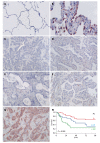C4.4A as a biomarker in pulmonary adenocarcinoma and squamous cell carcinoma
- PMID: 25302166
- PMCID: PMC4129527
- DOI: 10.5306/wjco.v5.i4.621
C4.4A as a biomarker in pulmonary adenocarcinoma and squamous cell carcinoma
Abstract
The high prevalence and mortality of lung cancer, together with a poor 5-year survival of only approximately 15%, emphasize the need for prognostic and predictive factors to improve patient treatment. C4.4A, a member of the Ly6/uPAR family of membrane proteins, qualifies as such a potential informative biomarker in non-small cell lung cancer. Under normal physiological conditions, it is primarily expressed in suprabasal layers of stratified squamous epithelia. Consequently, it is absent from healthy bronchial and alveolar tissue, but nevertheless appears at early stages in the progression to invasive carcinomas of the lung, i.e., in bronchial hyperplasia/metaplasia and atypical adenomatous hyperplasia. In the stages leading to pulmonary squamous cell carcinoma, expression is sustained in dysplasia, carcinoma in situ and invasive carcinomas, and this pertains to the normal presence of C4.4A in squamous epithelium. In pulmonary adenocarcinomas, a fraction of cases is positive for C4.4A, which is surprising, given the origin of these carcinomas from mucin-producing and not squamous epithelium. Interestingly, this correlates with a highly compromised patient survival and a predominant solid tumor growth pattern. Circumstantial evidence suggests an inverse relationship between C4.4A and the tumor suppressor LKB1. This might provide a link to the prognostic impact of C4.4A in patients with adenocarcinomas of the lung and could potentially be exploited for predicting the efficacy of treatment targeting components of the LKB1 pathway.
Keywords: Atypical adenomatous hyperplasia; LYPD3; Liver kinase B1; Ly6/Urokinase-type plasminogen activator receptor; Metaplasia; Non-small cell lung cancer; Precursor lesions; Prognosis; Solid growth pattern; Squamous differentiation.
Figures



References
-
- Ferlay J, Shin HR, Bray F, Forman D, Mathers C, Parkin DM. Estimates of worldwide burden of cancer in 2008: GLOBOCAN 2008. Int J Cancer. 2010;127:2893–2917. - PubMed
-
- Siegel R, Naishadham D, Jemal A. Cancer statistics, 2013. CA Cancer J Clin. 2013;63:11–30. - PubMed
-
- Gridelli C, De Marinis F, Di Maio M, Cortinovis D, Cappuzzo F, Mok T. Gefitinib as first-line treatment for patients with advanced non-small-cell lung cancer with activating epidermal growth factor receptor mutation: Review of the evidence. Lung Cancer. 2011;71:249–257. - PubMed
-
- Lynch TJ, Bell DW, Sordella R, Gurubhagavatula S, Okimoto RA, Brannigan BW, Harris PL, Haserlat SM, Supko JG, Haluska FG, et al. Activating mutations in the epidermal growth factor receptor underlying responsiveness of non-small-cell lung cancer to gefitinib. N Engl J Med. 2004;350:2129–2139. - PubMed
Publication types
LinkOut - more resources
Full Text Sources
Other Literature Sources
Miscellaneous

